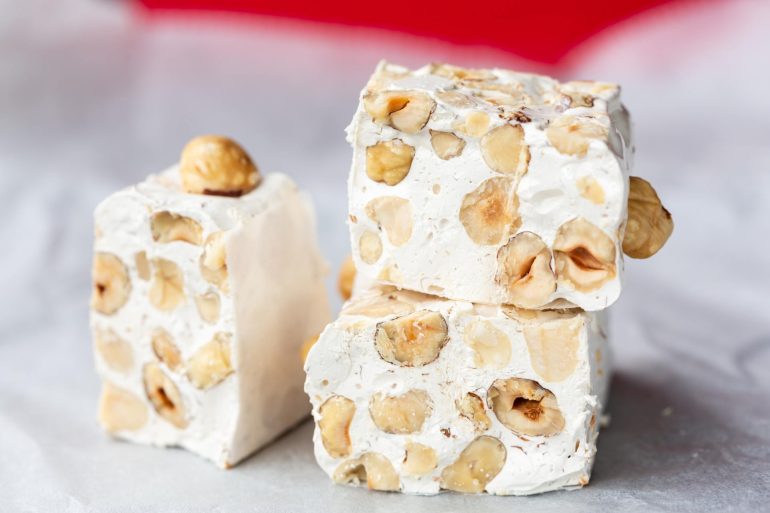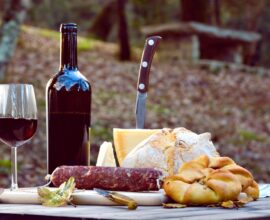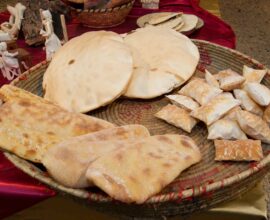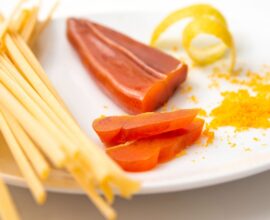Sardinian torrone: history and origins of the traditional confectionery
Sardinian torrone, all the sweetness of the holiday sweet
Torrone, with its ancient origins and unforgettable flavour, is one of Italy’s favourite holiday confectionary
Some dishes quickly enter the popular imagination and carve out a leading role in traditional meals. This is the case for the Sardinian artisan torrone, which soon became a real icon of the most popular holidays.
Its origins are lost in the mists of time and are disputed between various Italian and European locations in a story yet to be written. What is certain is that, in Sardinia, the presence of almond torrone is sanctioned, for the first time, in a document of 1614, preserved at the State Archives of Cagliari.
It is a contract that certifies the supply of black and white torrone between two inhabitants of Villanova, one of the historic districts of the city. What truly intrigues is the language, Catalan.
Numerous historical testimonies indicate the strong influence of the Iberian Peninsula on Sardinia, as also emerges from the architectural complexes of Alghero.
The term torrone derives from turron de Alicante, widespread at the time of the Arab presence in the Iberian peninsula. It is precisely from there where the almonds used to prepare the dessert come from. In a short time, this had conquered the areas of Mamoiada, Tonara, Sanluri, Pattada, Barbagia and Aritzo.
Tonara, the village linked to Sardinian torrone
In particular, on the island, the village of Tonara is deeply linked to the production of torrone.
In the heart of Barbagia, almost a thousand meters altitude in the province of Nuoro, we find the fairytale village, with ancient origins, far from the frenzy of the city and immersed in an idyllic landscape designed by woods, mountains and waterfalls.
The first evidence of its artisan torrone comes in the nineteenth century when the skilled hands of artisans prepared it between March and September.
First, they heated the honey in su cheddargiu, a copper vessel, placed it on a brick stove, sa forredda.
To ensure slow and smokeless combustion, the stove was fed with holly wood: the honey was left to cook for about four hours, stirring very patiently, without stopping.
Once ready, the peeled and toasted almonds were added: the mixture was finally placed in wooden containers lined with a thin wafer and waxed paper.
All that remained was to wait for it to cool to cut it and, finally, savour all its goodness.
Since 1979, on Easter Monday, Tonara hosts the “Sardinian Torrone Festival”, a long-awaited event that attracts visitors from every corner of Sardinia.
How Sardinian torrone is born, a delight to taste
The key ingredients of Sardinian torrone are honey and almonds: today the recipe also includes the addition of egg white but originally this delight was born from the slow cooking of local honey and almonds.
New ingredients or variants have been created over the years.
However, the element that distinguishes Sardinian torrone from other Italian torrone is the absence of sugar.
The film that protects the torrone, the wafer or host, is prepared with cornstarch, water and vegetable oil.
A holiday in Sardinia can then be a perfect opportunity, among other countless experiences to live, to discover and taste the authentic flavours of the island’s torrone, a way to get closer to the territory thanks to its culinary traditions.
Precisely for this reason, the Forte Village Resort in Santa Margherita di Pula in the province of Cagliari, an award-winning luxury resort accessible in the paradisiacal setting of a white sunny beach caressed by the turquoise sea, offers its guests a wide and selected range of gourmet restaurants that can satisfy all palates.
The best Italian and international chefs use only raw materials of the highest quality to give surprising “sensory experiences” to every bite, in a perfect balance between tradition, innovation and experimentation.
Would you like to taste the unforgettable flavours of Sardinian torrone and enjoy a fabulous holiday in an authentic paradise? Discover Forte Village Resort in Sardinia






